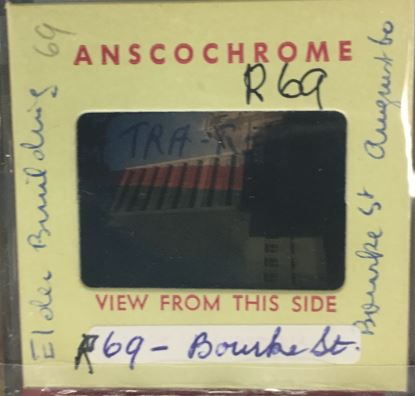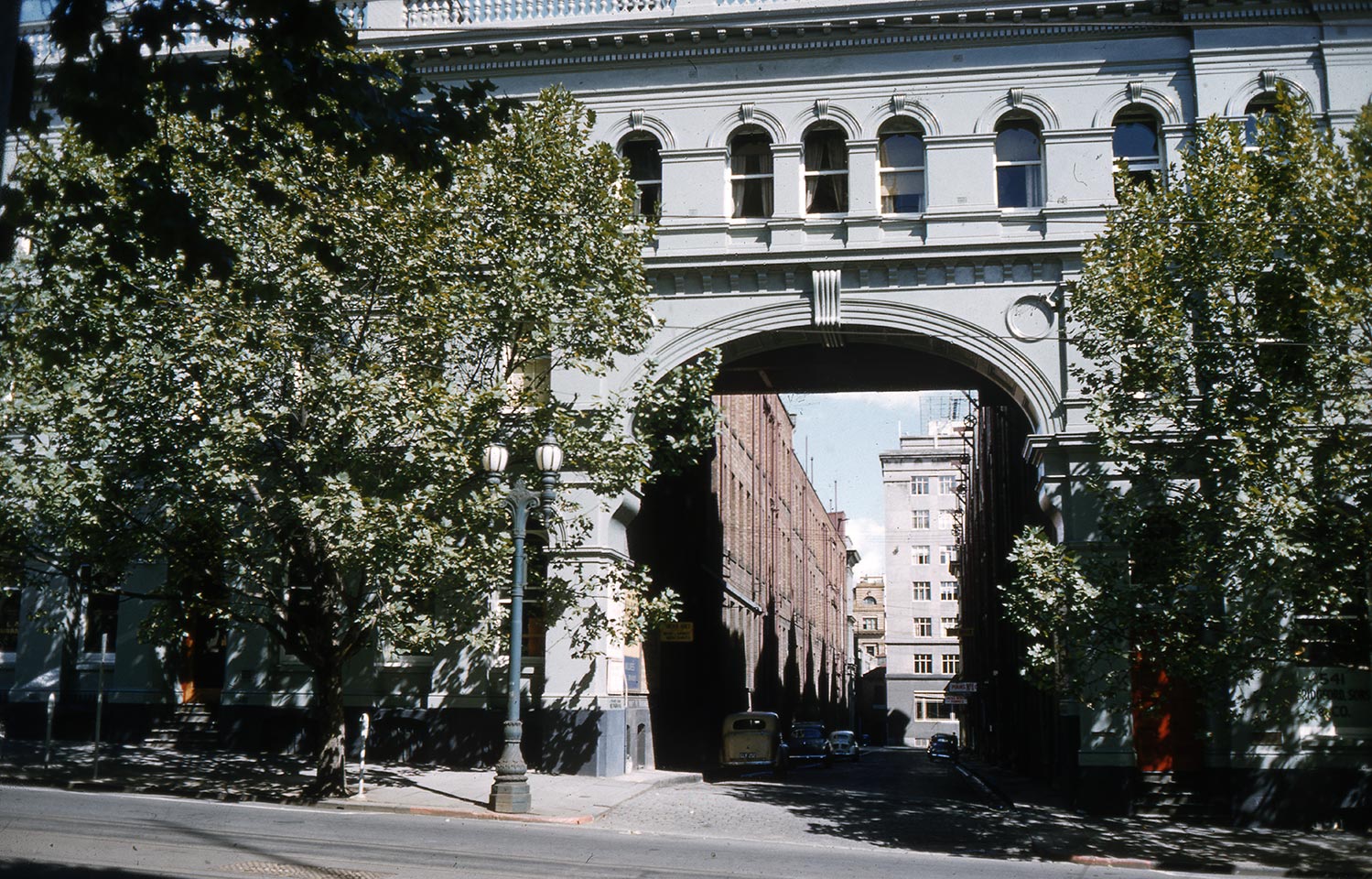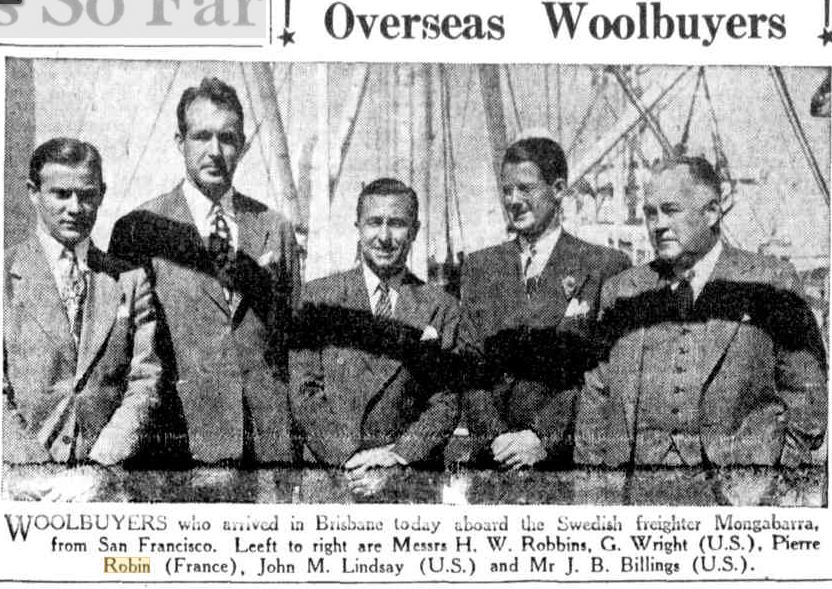The starting point for this project was an outdoor café scene in Collins Street, taken in the late 1950s, by a photographer called Pierre Robin.
As I looked through the RHSV publication Remembering Melbourne, I found other photos, all taken in the late 1950s by Pierre Robin and all of CBD street scenes.

Colonial Mutual Life Building. 308-320 Collins Street. September 1959. R-097. RHSV Images Collection.

Demolition of Shell corner, mid-1958. R-010. RHSV Images Collection.

Old Shell corner. North-west corner of Bourke and William Streets. Before demolition. April 1958. R-009. RHSV Images Collection.

Old Danks hardware store during demolition. May 1958. 391-403 Bourke Street. R-062. RHSV Images Collection.

Lonsdale Street looking east from near Queen Street. March 1959. R-217. RHSV Images Collection.

St Patrick’s Hall, 470 Bourke Street. 1957 demolition. R-002. RHSV Images Collection.
This piqued my interest – Who was Pierre Robin? And so I began my quest to discover his identity.
The story became more intriguing when in early 2020, RHSV Collections Manager Jillian Hiscock located 412 records of images by Pierre Robin in a yet-to-be-made-public database in what was described as the ‘Pierre Robin Collection of Transparencies’. Date range c1957-1966.
So, the RHSV holds over 400 colour slides taken by Robin at a time when huge changes were taking place in the streetscape of the CBD and Robin had enough interest to capture those changes taking place.
Images Collection volunteer Richard Barnden imagined Robin’s photographic process before the slides made their way into the RHSV Images Collection thus:
Equipped with a roll of 35 mm film in his camera (perhaps of Voigtlander or Kodak manufacture) Pierre Robin walked Melbourne’s streets in the late 1950s into the mid-1960s taking images of the changing face of the city evidenced in the destruction of heritage buildings and their replacement with modern steel and glass wall structures. Often his clue would be a ‘Whelan the Wrecker is Here’ sign. In some cases he took many images of the same site across time.
When he finished a roll of film of up to 36 exposures, he would need to have it processed and returned to him in a small slide box. Processing was either included with the original cost of the film roll or it had to be purchased – often in the form of a pre-paid postal packet. A major processing facility for Kodachrome and Ektachrome was at the Kodak factory in Coburg.
Upon their return, Mr Robin wrote brief (sometimes cryptic) notes on the mount. It cannot really be imagined that Mr Robin included these images in the ‘slide nights’ of trips and family gatherings that were a common feature of the late 1950s into the 1960s and beyond, often testing their audience’s patience and endurance. But as a matter of record, useful in teaching and illustrative settings, he obviously considered his actions of recording Melbourne’s history encapsulated in over 400 5 x 5 cm cardboard squares as worthy. These now form part of the RHSV Images Collection.



I still had not been able to identify Pierre Robin. Without donor information such as we collect today, I had little to go on. Yet it didn’t take me long to narrow the field. He is not listed anywhere as a professional photographer. I searched TROVE without success. The State Library of Victoria holds none of his images. It seems that the RHSV is the only public repository holding his photographs. The one remaining possibility (and the more I’ve researched, the more I’m convinced that I’ve ‘found’ the photographer) is a Pierre Joseph Ame Robin, wool buyer, Melbourne resident from 1939 until his death in 1971.
There is no way of telling for certain, at least without a family member confirming my conclusions, but if you follow the story outlined below, I think you’ll agree that this is likely to be our man.
Who was Pierre Robin?
Pierre Joseph Ame Robin was born on 8 December 1908 in Tourcoing, France. The town is in northern France near the Belgian border. This is Flanders, the area from which many wool buyers came to Australia, and Tourcoing had been a wool town since the Middle Ages.
Pierre had an older brother Paul who was also a wool buyer. Paul arrived in Australia in August 1926. There had been a visible French-speaking Flemish community in Australia’s wool buying firms since the late nineteenth century and Paul, who was based in Sydney, worked for the firm Emile Lahousse et fils. He married Laurel L. Cox in Sydney in 1928 and they had a daughter, Jacqueline, in 1929. The marriage ended in divorce in 1933, but Paul Robin remained in Sydney, although he travelled regularly between France and Australia, as did all foreign wool buyers.
The first sign of Pierre Robin on Australian soil was in September 1929 when he arrived in Fremantle from Marseilles. As a wool buyer he travelled regularly between France and Australia during the 1930s. His employer was the Compagnie d’Importation de Laines, based in his home town Tourcoing.
In 1938 Pierre Robin married in Perth, Western Australia – to Lexie Elizabeth Cumming. They lived in Claremont until war was declared, when they relocated to Melbourne.
As French citizens, Paul and Pierre Robin were called up for service in Indo-China in 1939, just before France declared war on Germany. The brothers fought in different regiments and Pierre was fortunate not to see any ‘hard fighting’. It was a different matter for 40 year old Paul, however. He was killed in action at Loc Binh, Tongking on the Chinese border at the Battle of Lang Son on 23 September 1940.
Pierre spent eight months in Indo-China, returning to Melbourne in November 1940. He became an Australian citizen in January 1942 and by then he was a resident of 22 Leura Grove, Hawthorn East, where he lived for the rest of his life.
His employer, the Compagne d’Importation De Laines, was based at Almora House, 522 Lt Collins Street, on the north side of the street near King Street. It is next to the St James’s Buildings and St James Street, both subjects of Robin’s photography. (An article on his photograph of the St James’s Building appears in the September 2020 edition of CBD News. https://cbdnews.com.au/st-james-buildings-bourke-st-frontage-1959/ )

St James Building, Bourke Street. Showing archway to St James Street, leading to Little Collins Street. March 1959. R-059. RHSV Images Collection.
The only photograph we have of Pierre Robin comes from the Brisbane Telegraph, 26 September 1946, the day on which he arrived in Brisbane after a business trip to the US.

Little more is known of Robin. He died on 9 December 1971 aged 63. His widow Lexie died in 1999.
It is likely that the Robin slides were donated after Lexie’s death, but we do not know for certain.
Until we unravel the full story of this remarkable donation, we are left with conjecture, about the man himself and about his interest in recording the changing face of the CBD.
An update – August 2021
Our recently appointed Images Collections Officer Helen Stitt has been working on the Pierre Robin Collection and informed me just a few weeks ago that we can now confirm that Lexie Robin was the donor of the images, so the story has been confirmed. A very satisfying outcome.
As Helen uploads the images in this important collection to our eHive catalogue, you can see for yourselves the scope of Robin’s work.
(Cheryl Griffin, 10 August 2021)
Sources
Naturalisation information, National Archives of Australia, NAA: A714, 13/6415
Shipping arrivals for Sydney, Fremantle, 1926-1937
Airline arrivals, New York, 1946
West Australian marriage index, 252/1938. Marriage of Pierre Robin
Sands and McDougall Directories, 1942, 1950
Victorian electoral rolls, 1943 to 1968
Age, 7 November 1940
Argus, 24 August 1946
Daily Telegraph, 14 Sep 1936, 7 November 1940
Evening News (Sydney), 18 September 1930
Le Courrier Australien, 18 October 1940
Sydney Morning Herald, 13 April 1933, 18 October 1940, 7 November 1940
Telegraph (Brisbane), 26 September 1946
West Australian, 19 August 1937, 14 March 1949
Victorian Death index, Pierre Joseph Ame Robin, 29875/1971
https://cbdnews.com.au/st-james-buildings-bourke-st-frontage-1959/
https://cbdnews.com.au/old-danks-store-yard-bourke-st-during-demolition-1958/

 239 A'Beckett Street Melbourne, Victoria, 3000
239 A'Beckett Street Melbourne, Victoria, 3000  03 9326 9288
03 9326 9288  office@historyvictoria.org.au
office@historyvictoria.org.au  Office & Library: Weekdays 9am-5pm
Office & Library: Weekdays 9am-5pm

